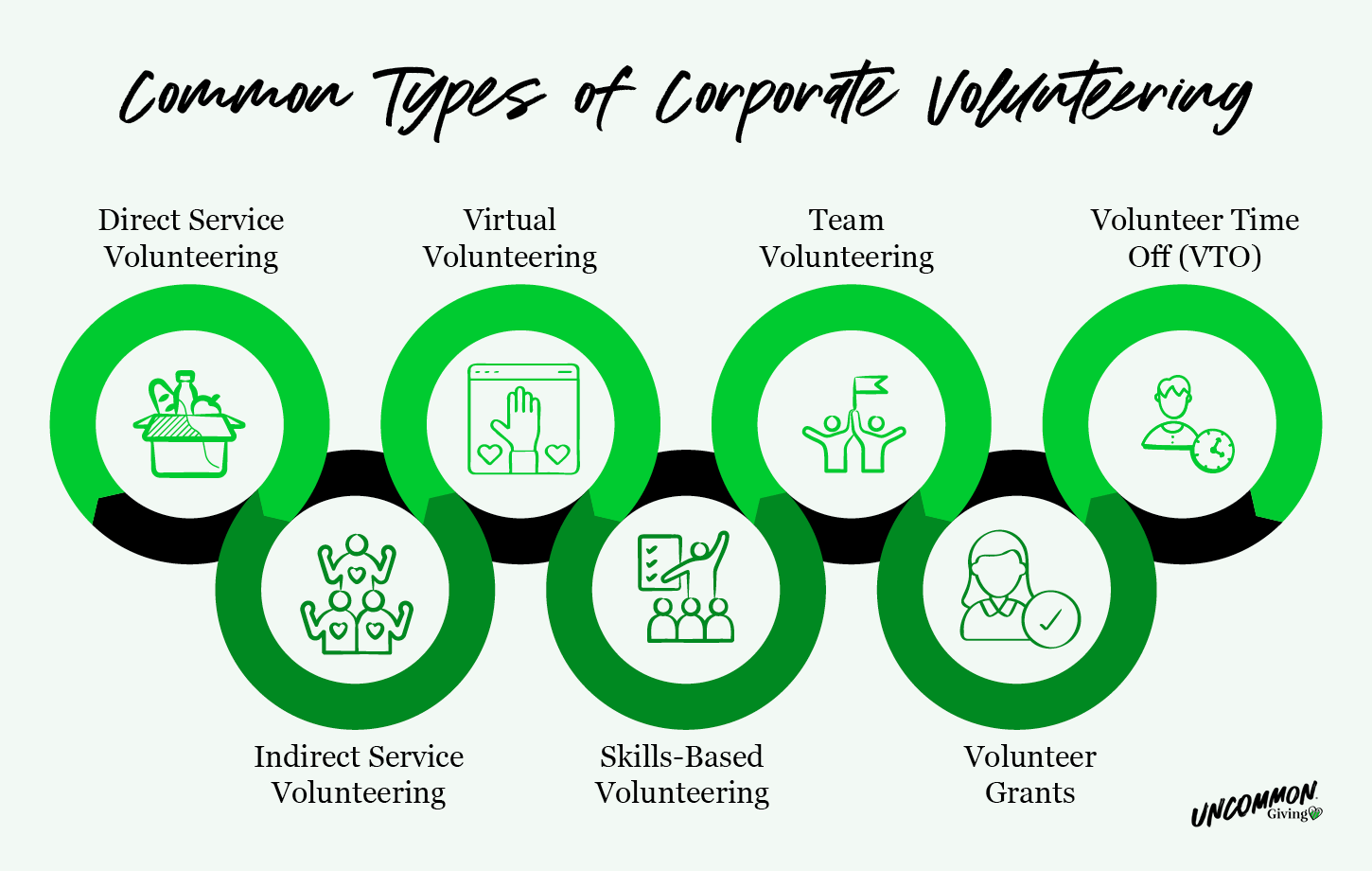5 Types of Corporate Giving to Start at Your Small Business
When it comes to corporate social responsibility (CSR), many assume that only large businesses like Fortune 500 companies have the resources to make a meaningful difference. In reality, however, businesses of all sizes can launch CSR programs that give back to their communities, engage employees, and boost their business’s reputation.
Starting a corporate giving program is often easier than you think. You just need the right tools, a couple of hours to hammer out your program policies, and an invested team to launch a successful giving initiative. And the very first step in this process is deciding what type of program you want to run.
In this post, we’ll explore five popular types of corporate giving programs that any business, regardless of size, can find success with.
1. Matching Gifts
Matching gifts are one of the easiest ways to participate in CSR and engage employees. Through this program, your business will match donations employees make to nonprofits. This allows employees to give more to their favorite organizations and reinforces that your business is committed to the same causes they care about.
To set up a matching gift program, your small business will need to establish eligibility requirements for:
- Employees. Some businesses only match gifts made by full-time employees, whereas others match full-time, part-time, and retired employees’ donations. A few businesses even match gifts made by employees’ family members! It’s also common for businesses to require employees to work a certain amount of time at the business before becoming eligible. For example, employees might have a six-month probation period and only become eligible after it’s completed.
- Nonprofits. Most businesses match donations to all 501(c)(3) nonprofits, excluding religious and political organizations and those in which employees have a financial stake, such as a nonprofit owned by a family member. Some businesses will also provide more generous matches to specific causes, such as educational institutions.
- Donations. To encourage employees to make larger gifts, many businesses set a minimum donation amount. Additionally, to avoid going over budget, businesses also often set annual donation caps per employee. For example, your business might match donations of $25 or more with a $1,000 cap per employee per year.
After solidifying your guidelines, your next steps are to roll them out to your business. While this might sound simple, many businesses’ matching gift programs go underutilized due to a lack of communication. Double the Donation’s CSR statistics report found that 78% of donors are unaware of whether their employer offers matching gift programs.
You can rectify this by investing in corporate giving software. These tools simplify program management, allowing you to easily process matching gift requests, keep employee donors informed about their gifts’ status, and track and communicate your programs’ accomplishments.
2. Corporate Volunteerism
Some employees want a more hands-on experience when it comes to giving back. You can help facilitate this by offering a wide range of volunteer programs. Uncommon Giving’s guide to corporate volunteerism covers several popular program types:

- Direct service volunteering involves employees directly interfacing with the nonprofit’s constituents. For example, employees mentoring kids as part of a youth program would be direct service volunteering.
- Indirect service volunteering includes any volunteer activity where employees don’t directly interact with a nonprofit’s beneficiaries. For instance, an employee might help a nonprofit set up an event space or man a booth at a community event to spread awareness to donors.
- Virtual volunteering allows employees to contribute to the causes they care about remotely. They might perform administrative work or fundraise online on the nonprofit’s behalf.
- Skills-based volunteering lets employees lend the skills they use every day at your business to nonprofits. Graphic designers might make free brand materials, accountants might help nonprofits file their taxes, and programmers might debug a nonprofit’s website.
- Team volunteering combines volunteering with team-building, allowing your business to give back and strengthen internal teams at the same time. Arrange team volunteer opportunities by contacting nonprofits ahead of time to ensure they have large projects available that your staff can work on together.
- Volunteer grants enable you to support the causes your employees care about by making financial contributions based on the number of hours employees volunteer. For instance, you might pledge to donate $15 for every hour an employee volunteers with an eligible nonprofit.
- Volunteer time off (VTO) gives employees the ability to take time off specifically to volunteer. This enables them to volunteer during normal work hours without sacrificing a paycheck.
Your business can offer one or multiple volunteerism initiatives. For instance, you might arrange annual volunteer days as a team-building activity while also maintaining a volunteer grant program.
3. In-Kind Donations
If your business has products or services that nonprofits need, consider giving back through in-kind donations. These are gifts of products or services rather than financial contributions. For instance, a clothing retailer might donate sweaters to a homeless shelter, or a photographer might lend their services to a nonprofit that needs promotional photos. Or, any small business can host a canned food drive among employees and donate the cans to a soup kitchen.
In-kind donations of services can also help you improve employee engagement. Many employees will appreciate the opportunity to lend their skills to a cause in need and get some extra experience in the process.
4. Payroll Giving
Help employees give back by making donating as easy as possible through payroll giving. Employees who enroll in these programs designate a portion of their paychecks to be automatically donated to a trusted nonprofit. This means they can give without even needing to lift a finger, turning donating into a set-it-and-forget-it process that everyone benefits from.
To launch a payroll giving program, your nonprofit needs a corporate giving tool that integrates with your payroll system. Employees should be able to choose how much they want to give and how often (every paycheck, once a month, etc.), and your corporate giving tool will then make automatic deductions according to their directions.
Boost employee engagement by giving participants a choice in which nonprofit they give to. Most businesses with payroll giving programs have a select few approved nonprofits that employees can support. However, some corporate giving software solutions allow employees interested in this type of workplace giving to browse through millions of vetted nonprofits to find causes that resonate with their values.
5. Matching Grants
Help a nonprofit motivate its supporters to give more by providing a match grant. While the names are similar, matching gifts and matching grants are two different types of corporate giving. Here’s a breakdown of their differences:
- Matching gifts involve your business matching individual employees’ donations to eligible nonprofits of their choice.
- Matching grants are a partnership between your business and a specific nonprofit in which your company pledges to match all gifts donated to a certain campaign or during a set period of time.
For example, your business might provide a matching grant to a local nonprofit on Giving Tuesday. Say that the nonprofit fundraises $10,000 during that 24-hour period. Then, your business donates $10,000 as well, enabling them to double their earnings.
Matching grants are useful for forming tight partnerships with value-aligned nonprofits. Through these partnerships, nonprofits can incentivize their supporters to give more with the knowledge that their gifts will be doubled. On your business’s end, these fundraisers tend to heavily promote the organization doing the matching, helping boost your reputation in your local community.
Whether you’re starting a matching gift program, a volunteer initiative, or a one-time matching grant partnership, corporate giving can elevate your business in a number of ways. Survey your team and assess local nonprofits in your community to choose a program that helps you retain employees, boost your reputation, and reach new audiences.
